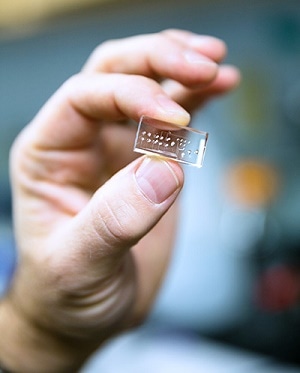Sep 15 2016
 A new optofluidic platform for biological sample processing and optical analysis is made of polydimethylsiloxane (PDMS) and features tunable optics and novel 'lightvalves.' (Photo by C. Lagattuta)
A new optofluidic platform for biological sample processing and optical analysis is made of polydimethylsiloxane (PDMS) and features tunable optics and novel 'lightvalves.' (Photo by C. Lagattuta)
Electrical engineer Holger Schmidt has been involved in the development of devices for optical testing of samples on integrated chip-based platforms for the last ten years, with the aim to use them in areas such as virus detection, biological sensors, and chemical analysis.
The most recent device from his laboratory is based on novel technology that integrates dynamic optical tuning and switching with high-performance microfluidics for sample processing, all on an economical "chip" formed using a flexible silicone material.
In the earlier devices from Schmidt's laboratory, optical operations were incorporated into silicon chips using the same fabrication technology applied to manufacture computer chips. The new device is made completely from polydimethylsiloxane (PDMS), a soft, flexible material used in microfluidics as well as in products such as medical devices and contact lenses.
We can use this fabrication method now to build an all-in-one device that allows us to do biological sample processing and optical detection on one chip.
Holger Schmidt, Professor, UC Santa Cruz
Schmidt is the Kapany Professor of Optoelectronics and director of the W. M. Keck Center for Nanoscale Optofluidics at UC Santa Cruz.
Lightvalve
The flexibility of PDMS creates novel methods of manipulating both fluids and light on the chip. Using multilayer soft lithography methods, senior graduate student Joshua Parks manufactured chips composed of both solid-core and hollow-core waveguides for steering light signals, as well as fluidic microvalves to manipulate the movement of liquid samples. Schmidt and Parks also created a special microvalve that functions as a "lightvalve," managing the flow of both fluids and light.
That opens up a whole new set of functions that we couldn't do on a silicon chip. The lightvalve is the most exciting element. In additional to a simple on-off switch, we built a moveable optical trap for analysis of biological particles such as viruses or bacteria.
Holger Schmidt, Professor, UC Santa Cruz
Parks and Schmidt published the results of the preliminary experiments with the new device in Nature Scientific Reports.
In an earlier study, Schmidt, Parks, and colleagues at BYU and UC Berkeley showcased a hybrid device in which a silicon-based optofluidic chip for optical detection of viral pathogens was combined with a PDMS microfluidic chip for sample preparation. The new device integrates both operations on the same chip.
Further, Schmidt added, the materials are comparatively low cost, allowing quick prototyping of devices.
We can do the full chain of fabrication here in our lab, and we can make new devices very quickly.
Holger Schmidt, Professor, UC Santa Cruz
Diagnostic Assays
Schmidt explained that the potential applications for this technology include a broad range of analytical devices and biological sensors. For example, in viral diagnostic assays fluorescently labeled antibodies can be applied to mark specific viral strains for optical detection.
Schmidt and colleagues explained how to detect and identify different flu strains with fluorescence detection in a multi-mode interference (MMI) waveguide. They demonstrated that they can dynamically tune an MMI waveguide on the chip using the new device.
The dynamic tuning of the optofluidic device is accomplished by applying pressure to the optofluidic channel, altering its dimensions and thus changing its photonic properties. "We can actually tune the spot pattern made in the channel by the interference waveguide, which we couldn't do with the silicon chip," Schmidt said.
This research was supported by grants from the National Science Foundation and National Institutes of Health.